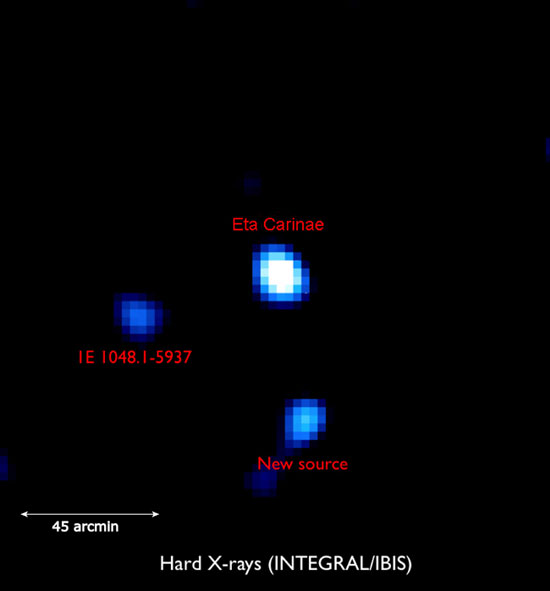Violent Collision of Stellar Winds Detected

For thefirst time, astronomers have pinpointed the spot where the intense winds of twomassive stars in a binary system violently collide and detected the productionof high-energy X-rays there.
Themonstrously large Eta Carinae binary contains between 100 and 150 times themass of the sun and glows more brightly than four million suns together. Theso-called hypergiant contains two massive stars, the second of which was not discovereduntil 2005.
Astronomershave long suspected that the stellar pair should give off high-energy X-rays,but until now, they didn't have the instruments to detect the radiation. Butthe European Space Agency's Integraltelescope, launched to detect some of the most violent events in theuniverse, has conclusively detected such X-rays emanating from Eta Carinae,more or less as astronomers had thought.
"Theintensity of the X-rays is a little lower than we expected, but given that thisis the first-ever conclusive observation, that's OK," said Jean-ChristopheLeyder of the University of Liege in Belgium, one of the astronomers who madethe discovery.
Stellarwind shockwave
The intenseX-rays are generated by the collision of the massive stars' stellar winds,flows of charged gas ejected from the stars' upper atmospheres.
The lightand other radiation that "blows" off these particles is so strongthat the stellar winds of Eta Carinaecan reach speeds of 900 to 1200 miles per second (1,500 to 2,000 kilometers persecond). Because the two stars are in such close proximity, the winds collidein a ferocious shockwave where temperatures reach several thousand milliondegrees Kelvin.
Breaking space news, the latest updates on rocket launches, skywatching events and more!
"It'sa very tough environment," Leyder said.
Electronsget caught in the magnetic environment of the shockwaves and are bounced backand forth, accelerating to huge energies. When they finally burst out of theshockwave, they collide with low-frequency photons and give them an energyboost, creating the high-energy X-ray emissions spied by Integral.
Searchfor other emitters
Findingother examples of colliding-wind binaries, as astronomers call them, is toughbecause massive stars are rare; finding two in a binary system is rarer still.
"Inour galaxy, there are probably only 30 to 50 colliding-wind binaries thatdisplay a clear signature of wind-wind collision," Leyder said. Thismeager number of stars is just a tiny fraction of the galaxy's stellarpopulation. So to have an example such as Eta Carinae on our cosmic doorstep isa stroke of luck.
Astronomersdid detect X-rays emitted from another colliding-wind binary, HD 5980, in ourgalactic neighbor the SmallMagellanic Cloud last year.
The X-raysdetected from Eta Carinae are of a much higher energy though. Astronomers estimatethat the Eta Carinae system loses one Earth mass per day of ejected material,roughly 140 times higher than the mass loss rate of HD 5980.
Understandingthe X-ray emissions from stellar winds is important because stellar windsaffect the evolution of stars and the chemical evolution of the universe, whilealso acting as a source of energy in the galaxy.
- Video: When Stars Collide
- Image: Blown to Smithereens
- The 10 Brightest Stars

Andrea Thompson is an associate editor at Scientific American, where she covers sustainability, energy and the environment. Prior to that, she was a senior writer covering climate science at Climate Central and a reporter and editor at Live Science, where she primarily covered Earth science and the environment. She holds a graduate degree in science health and environmental reporting from New York University, as well as a bachelor of science and and masters of science in atmospheric chemistry from the Georgia Institute of Technology.
